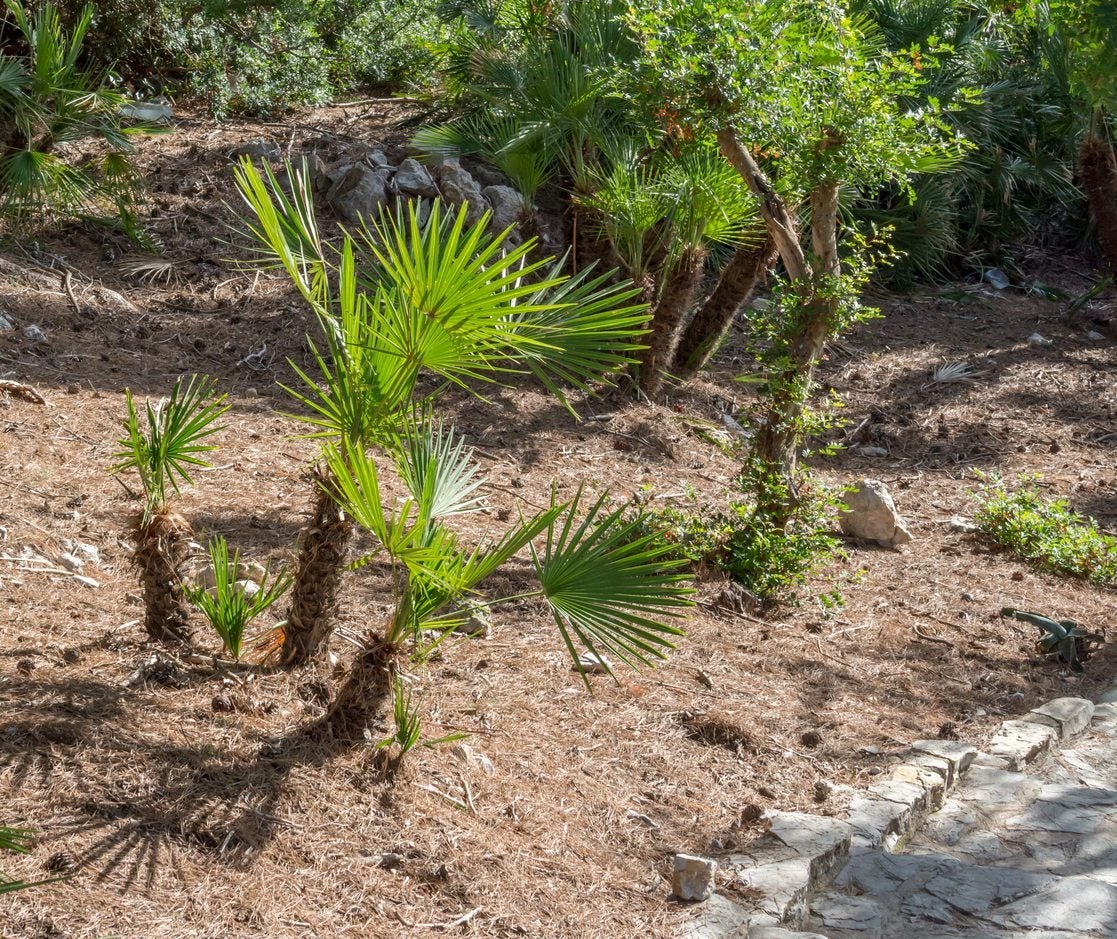Fan Palm Houseplant: How To Grow Fan Palm Trees Indoors

Not everyone has the right growing conditions in which to enjoy a taste of the tropics in their garden. However, this doesn't stop gardeners from enjoying the relaxed, yet elegant feel of tropical plants. Fan palm trees are among the most popular of indoor tropical plants and require bright light conditions and ample space to thrive. Keep reading for tips on growing fan palms.
Types of Fan Palms
Chinese fan palms (Livistona chinensis) are very popular in the Florida landscape but also make an excellent indoor plant for a sunny room. This neat palm is slow growing and has a single, upright trunk and large leaves that can reach up to 6 feet (2 m.) in length. The European fan palm (Chamaerops humilis) is an attractive, multi-stemmed palm for indoor use. Fronds are fan shaped and sit atop a 4 foot (1 m.) stem. Leaves are grayish green in color and about 2 feet (61 cm.) across at maturity.
Choosing Your Fan Palm Houseplant
The healthier your plant is when you bring it home, the likelier it is to thrive when given the correct attention. Don't choose plants with extremely dry soil, browning leaves, or apparent damage. Fan palms should have rich green foliage and an upright, healthy habit. Starting with a healthy plant will make it much easier to care for your new potted fan palm.
How to Grow Fan Palm Plants
Potting soil used for palm plants should be well draining and any container used for the plant should have ample drainage holes in the bottom. Soil should be moist at all times during the growing season, although it is essential to avoid over-saturation, which can lead to root rot. Growing fan palms isn't difficult as long as you provide a room temperature of 55 to 60 degrees F. (13-16 C.). Keep indoor palm plants away from heating or cooling vents and ceiling fans that may cause temperature fluctuations. Unlike many other types of palms, fan palms do best with at least four hours of direct sunlight daily. A south or west facing window is best.
Fan Palm Care Tips
Allow the plant soil to dry out a little more in the winter than in the summer. A daily mist of water helps to keep humidity levels high. If frond tips become brown, the humidity is too low. A light fertilizer application from late winter through early fall helps fan palm plants remain vital. Spider mites like dusty foliage, so it is critical that fronds are wiped clean on a regular basis. If mites become a problem, use a soapy water mixture to control infestation.
Gardening tips, videos, info and more delivered right to your inbox!
Sign up for the Gardening Know How newsletter today and receive a free copy of our e-book "How to Grow Delicious Tomatoes".
-
 Looking For Plants To Give You The Soft And Fuzzies? Try These 5 Fuzzy Leaf Plant Options
Looking For Plants To Give You The Soft And Fuzzies? Try These 5 Fuzzy Leaf Plant OptionsLovers of texture, drama, silver foliage and tactile plants will adore these special sensory garden additions. These fuzzy leaf plant options will leave you all aglow
By Susan Albert
-
 Get Ready For A Summer Of Hummers! Grow These Full Sun Hummingbird Plants and Flowers
Get Ready For A Summer Of Hummers! Grow These Full Sun Hummingbird Plants and FlowersIf you’re lucky enough to enjoy a sunny backyard, make sure you are maxing out on your pollinator opportunities and grow these full sun hummingbird plants and flowers
By Tonya Barnett
-
 Potted Ruffled Fan Palm Care – Growing Ruffled Fan Trees Indoors
Potted Ruffled Fan Palm Care – Growing Ruffled Fan Trees IndoorsAre you looking to grow a ruffled fan palm in a pot? Ruffled fan palms are an unusual and gorgeous species of palm grown for their gorgeous pleated, or ruffled, leaves. Growing ruffled fan tree is pretty easy if you follow the basic care found in this article.
By Raffaele Di Lallo
-
 Mexican Fan Palm Info – Learn About Growing Mexican Fan Palms
Mexican Fan Palm Info – Learn About Growing Mexican Fan PalmsMexican fan palm trees are very tall palm trees native to northern Mexico. They are attractive trees with wide, fanning, dark green leaves. Learn more about Mexican palm care and how to grow a Mexican fan palm tree in this article.
By Liz Baessler
-
 Fan Palm Information – Tips On Caring For California Fan Palms
Fan Palm Information – Tips On Caring For California Fan PalmsAlso known as the desert fan palm, the California fan palm is a grand and beautiful tree that is perfect for dry climates. If you live in an arid or semiarid climate, consider using one of these tall trees to anchor your landscape. This article will help get you started.
By Mary Ellen Ellis
-
 Fan Palm Information: Learn How To Grow Mediterranean Fan Palms
Fan Palm Information: Learn How To Grow Mediterranean Fan PalmsWith multiple brown trunks of fibrous bark that are scaled like a pinecone from top to bottom and triangular fan-shaped leaves, fan palms beckon weirdness, leaving us awestruck and wanting to know more about them. This article aims to help with that.
By Shelley Pierce